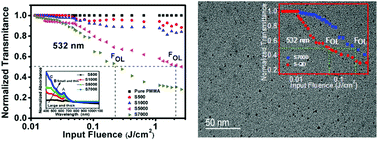Tuning nonlinear optical absorption properties of WS2 nanosheets†
Abstract
To control the optical properties of two-dimensional (2D) materials is a long-standing goal, being of both fundamental and technological significance. Tuning nonlinear optical absorption (NOA) properties of 2D transition metal dichalcogenides in a cost effective way has emerged as an important research topic because of its possibility to custom design NOA properties, implying enormous applications including optical computers, communications, bioimaging, and so on. In this study, WS2 with different size and thickness distributions was fabricated. The results demonstrate that both NOA onset threshold, FON, and optical limiting threshold, FOL, of WS2 under the excitation of a nanosecond pulsed laser can be tuned over a wide range by controlling its size and thickness. The FON and FOL show a rapid decline with the decrease of size and thickness. Due to the edge and quantum confinement effect, WS2 quantum dots (2.35 nm) exhibit the lowest FON (0.01 J cm−2) and FOL (0.062 J cm−2) among all the samples, which are comparable to the lowest threshold achieved in graphene based materials, showing great potential as NOA materials with tunable properties.


 Please wait while we load your content...
Please wait while we load your content...